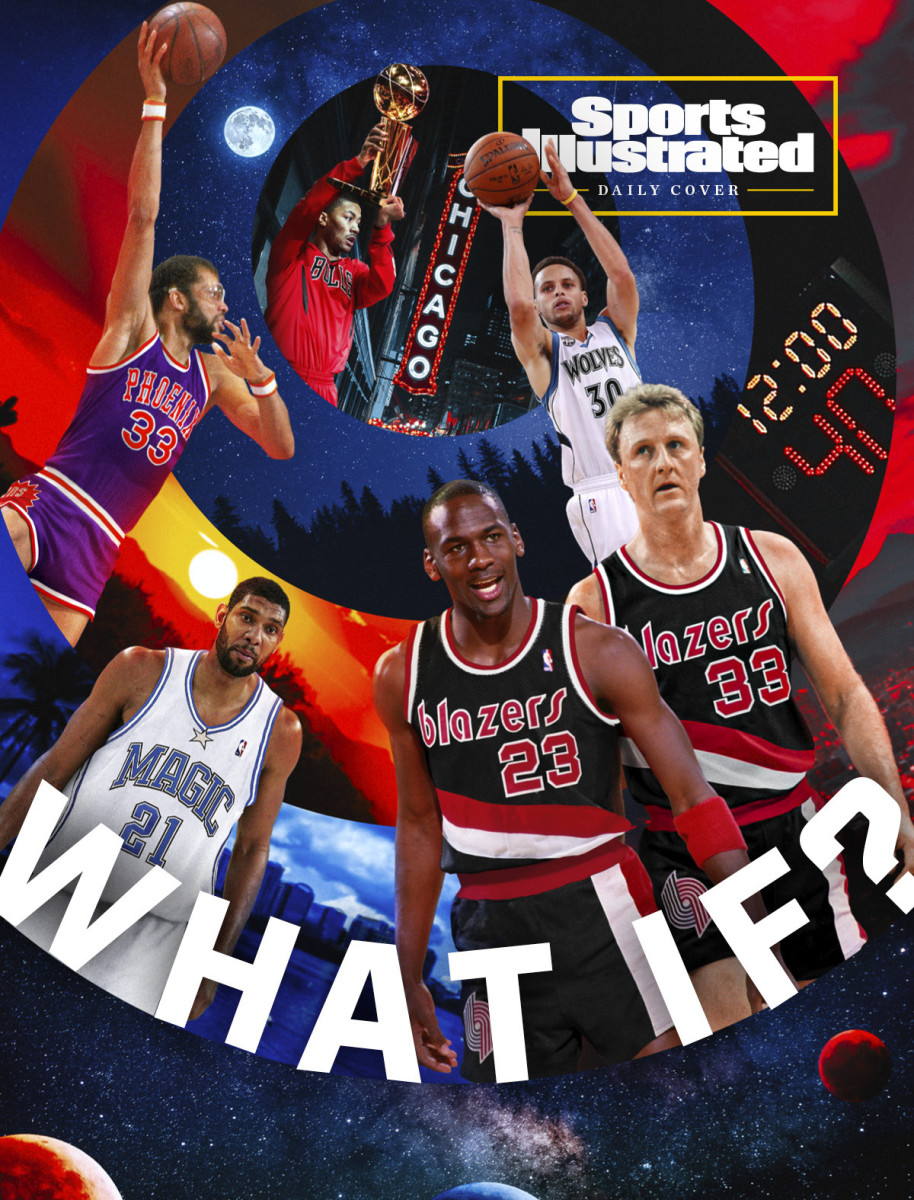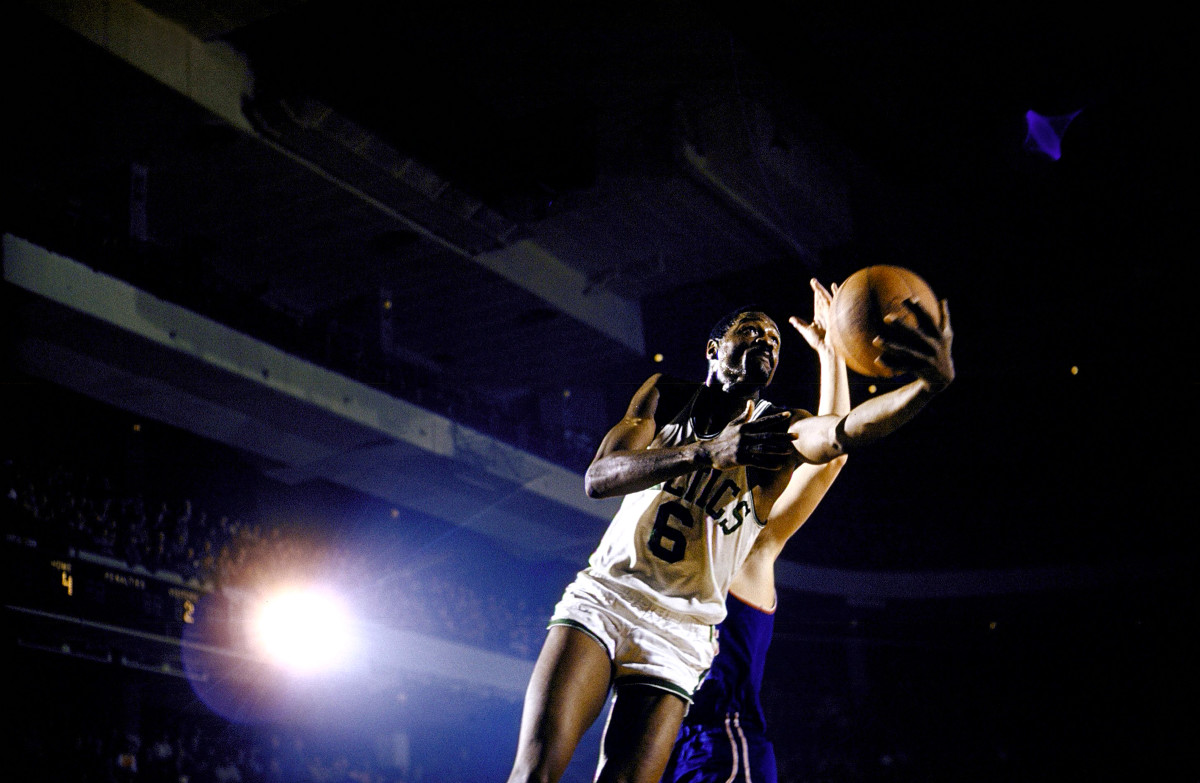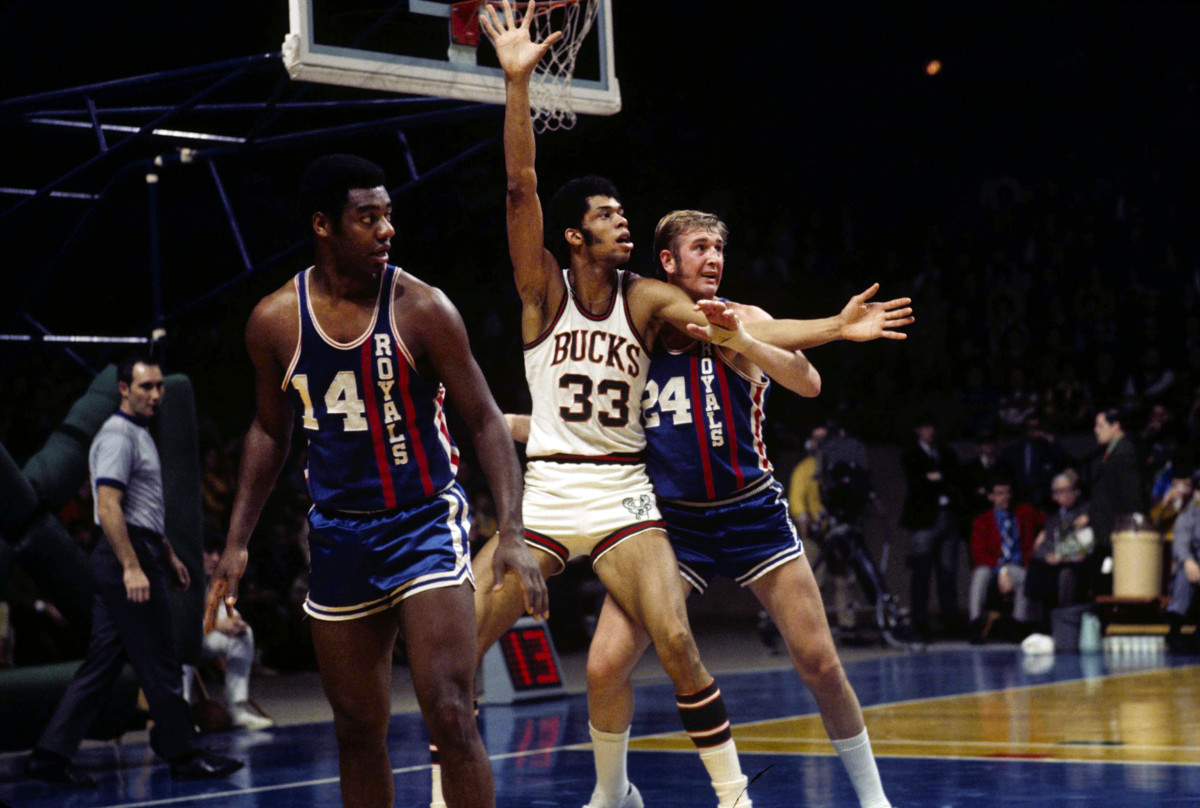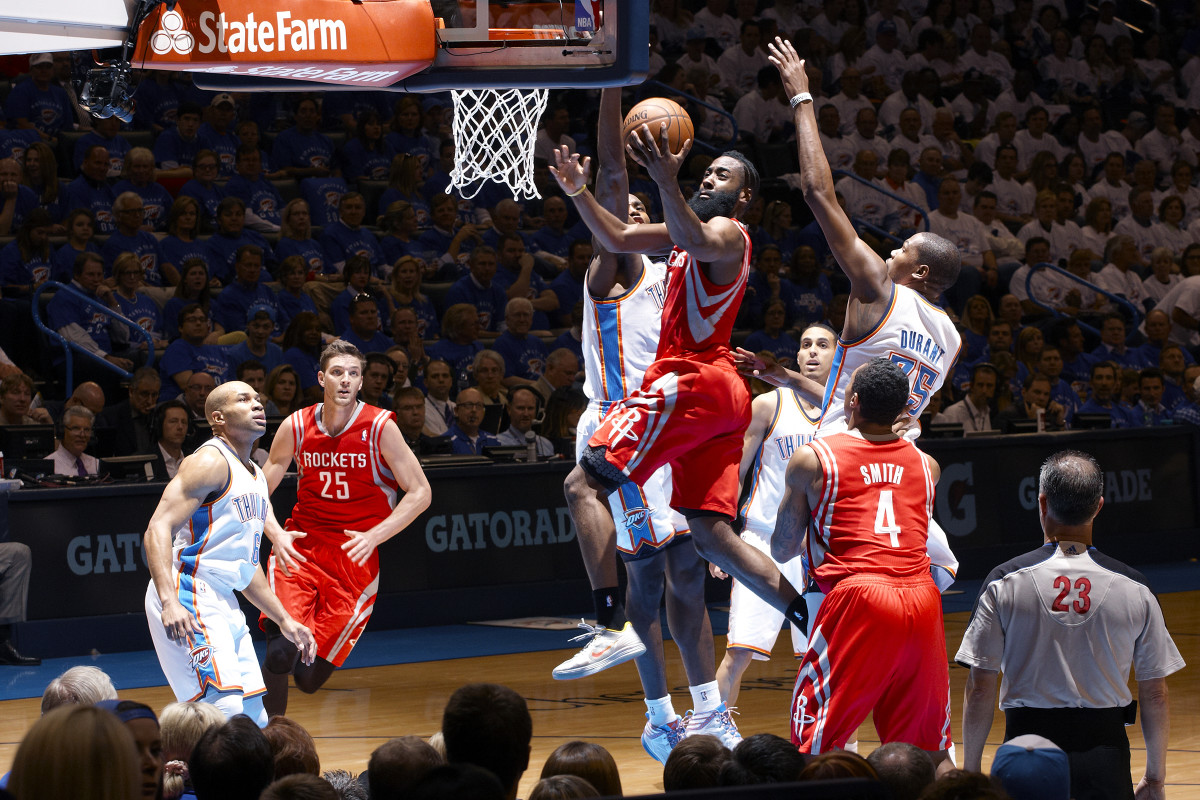75 Years of NBA Coulda-Beens
Another world lies tangent to our own—where everything is whackeyed. You wear purple skirts; you leave the dustcloth on translucent shelves; the sun is slightly green.
—Dick Allen
It behooves one to note that the Dick Allen who wrote the opening stanza above for “Theory of the Alternate Universe” is the late award-winning poet and not the iconoclastic line-drive hitter, who should, by the way, be in the Hall of Fame. Given his unpredictable nature and the fact that he scratched words into the dirt with the toe of his spikes (“Oct. 2,” “Coke,” “Boo”; you can look this up), Allen would certainly have been a fan of alternate universes, particularly if he could’ve been transported to one during the 1969 season when he unhappily patrolled first base, and doodled, for the 63–99 Philadelphia Phillies.
In recognition of the NBA’s 75th anniversary—during which it will unveil its choices for the Top 75 Players of All Time, thus giving young fans the chance to ask that age-old question: “Wait … who the hell is Dolph Schayes?”—we hereby present an Alternate Universe, a list of 10 what-ifs that could’ve changed NBA history.
Incidentally, I participated in the Top 50 voting 25 years ago and still had enough brain cells left to cast votes for the top 75. I hasten to add that I was not born when the league opened its doors as the Basketball Association of America (BAA) in 1946. Not quite, anyway. I came around in ’49, several months after the Minneapolis Lakers won the first of their five championships, beating the Washington Capitols, who were coached by a cigar-chomping relative unknown named Arnold Auerbach.
So here are our 10 what-if-this-happened-instead-of-that? scenarios. Feel free to think of your own, and write them in infield dirt if you can find any.

1. What if Danny Biasone’s boat had been sent back to Italy?
Biasone was a 10-year-old boy when he arrived at Ellis Island with his mother and brother, but the ship that carried him here remained anchored in New York Harbor for a week. There was a flu epidemic and customs officials huddled for a long time before letting everyone off. (Why, can you imagine something like that happening today?) Once in America, the enterprising Biasone bought a bowling alley, and then the Syracuse Nationals, and then came up with the 24-second clock that may have saved the NBA from extinction.
Back in the early days, stall ball, which consisted of a team endlessly passing the ball back and forth on the perimeter to preserve a lead, had become a recognized stratagem. (For whatever reason, the idea of countering by double- and triple-teaming the ball to force action had not become a recognized stratagem. I’m trying to imagine Hubie Brown watching a stall-ball game.) On Nov. 22, 1950, the Fort Wayne Pistons famously beat the Minneapolis Lakers 19–18 as fans dozed. Fort Wayne’s leading scorer John Oldham had five points, while Minneapolis star George Mikan had 15 of the Lakers’ 18.
Biasone, who was born in Miglianico in the foothills of the Apennines, said, Abbastanza! Enough! As arenas continued to hemorrhage fans, a couple of years later Biasone and his general manager Leo Ferris sat down and calculated that, in games when the scoring was “normal,” each team took about 60 shots, or 120 combined. So they took 2,880 (the number of seconds in a 48-minute game) and divided it by 120. Voilà! Or Ecco!
Now, would someone else have eventually come up with a clock? Undoubtedly. But who knows if it would’ve been 24 seconds, one of those perfect mathematical accidents, like 90-foot bases? Maybe it would’ve been 28? Maybe 30? Maybe 40?
Bonus Fact: The late Schayes, one of the league’s first true superstars, a 6' 8" all-around player who was chosen as one of the league’s top 50 all-time players (and will probably hang in there to make the 75 team), played in the clock’s demonstration game in August 1954. It was rolled out, with much trepidation, for the ’54–55 season and has never gone away.
Bonus Fact No. 2: Fittingly, Biasone’s and Schayes’s Nationals won the title in the first year of the clock.
Bonus Fact No. 3: Schayes is the father of center Danny Schayes, who played for seven teams over 18 NBA seasons after getting screamed at by Jim Boeheim during his four years at Syracuse.
2. What if Ben Kerner had had more vision—or at least a bigger set of ... ?
The St. Louis Hawks owner always insisted that he knew exactly what he was giving up when he traded Bill Russell, his pick in the 1956 draft, to the Boston Celtics for Cliff Hagen and “Easy” Ed Macauley. But he said he had to do it because he needed Macauley, a Missouri native and St. Louis University star, to fill seats. And look, “Easy” Ed, the MVP of the first NBA All-Star Game, was pretty damn good.
But more to the point, there was also that matter of St. Louis’s being a racist town, where Russell would not have been, to say the least, a fan favorite.
Kerner’s Hawks did get one championship, in 1958. But Russell not only created a dynasty in Boston, but he also changed the game, enabling the Celtics to become a transition team off his ability to block shots, rebound, throw the outlet pass and even finish on the other end.

3. What if the Dodgers and Giants hadn’t moved to the West Coast?
The idea of westward expansion in sports was once considered a risky and revolutionary proposition. Everyone in the sports world, including Minneapolis Lakers owner Bob Short, was anxiously studying how the transcontinental experiment would work out for the New York baseball clubs, both of which began their California dreamin’ in 1958. It worked out well, so Short, armed with a show-providing talent in Elgin Baylor and the draft pick that would become Jerry West, passed up the cold winds of Chicago in favor of the warm climes of L.A.
Would some other franchise have eventually done it? Sure. But perhaps not the Lakers, and we would never have had the eternal L.A. presence of West or possibly even Showtime as we came to know it. Los Angeles Lakers rolls off the tongue so easily that we don’t even notice anymore that the name is no more appropriate than Utah Jazz.
4. What if Jerry Colangelo had called tails?
Throughout NBA history there have been several one-deep drafts, i.e., a draft where one player is so superior to all the others that there’s not even room for a reasonable discussion about who the top pick should be. A quick list would include Magic Johnson in 1979, Shaquille O’Neal in ’92, Tim Duncan in ’97 and LeBron James in 2003. But, to my mind, the clearest one one-deep draft in history was in ’69 when Lew Alcindor was the player who would surely be taken by the winner of a coin flip between two second-year expansion teams—the Suns in the Western Conference (16–66 record in ’68–69) and the Bucks in the East (27–55). (Meanwhile, Alcindor was thinking, Why the hell can’t I play in L.A. or New York?)
The Bucks won that coin flip after Colangelo's call, and Alcindor turned Milwaukee around immediately, and they won a championship in his second season, albeit with Oscar Robertson at point guard. The Suns, meanwhile, with second pick Neal Walk at center, didn’t even make the Finals until 1976 when they lost to the Celtics. Eventually, Alcindor, who by then had become Kareem Abdul-Jabbar, asked out of Milwaukee, but the Bucks had their title, and didn’t win another until 2021.

5. What if the phrase “He’s going back to school” hadn’t been so scary to so many?
The notion of Larry Bird considering sitting in, say, geography class instead of busting chops (and earning a million bucks) in the NBA seems farfetched, not to mention quaint. But that was Bird’s decision in 1978 when he became eligible for the NBA draft because his original college class had graduated. (Bird had originally enrolled at Indiana to play for the Hoosiers in ’74 before leaving Bloomington and spending a year at a junior college.)
Bird’s decision to return to Indiana State accomplished two things: First, it set up his still-remembered Clash of the Titans battle against Michigan State sophomore Magic Johnson in the 1979 NCAA final. Second, it scared off five teams that didn’t want to wait a year to get a top player. They were his home state Pacers, the Portland Trail Blazers, the Kansas City Kings, the New York Knicks and the Golden State Warriors.
But not the Boston Celtics and specifically Auerbach, who had this novel thought: “Wait a minute, there will still be a league in 1979. And the year after that. And the year …” So he selected Bird, watched the Celtics struggle to a 29–53 record in ’78–79 without him … then win 61 games with Rookie of the Year Bird the following season. And eventually three championships and two additional trips to the Finals.
6. What if the Trail Blazers hadn’t been so in love with ... Jim Paxson?
The fact that the Trail Blazers eschewed Michael Jordan in the 1984 draft in favor of Sam Bowie has always come down to the Big Man Was More Valued Back Then Theory. Well, O.K. The second reason given for this seemingly incomprehensible decision is Clyde Drexler. Portland didn’t need a two guard because it had The Glide, a two guard, and, moreover, a Jordan type—exciting and athletic.
But what’s often forgotten is that the star in Rose City as Jordan was coming out was another two guard, Jim Paxson, who averaged 21 points a game in the 1983–84 season. As for rookie Drexler in ’83–84? He started exactly three games, averaged only 17 minutes and was pretty much eighth man in the rotation. There’s little doubt that they were counting on more from The Glide for more than that in the years to come, but, as much as anything, the Blazers loved Pax, and that figured heavily into the decision to pass on Jordan.
We can’t let the Blazers off this easily, though. Every franchise has a drafting or personnel skeleton or two in their closet, but this wasn’t the first or last inexplicable draft decision made by Portland. Let’s go chronologically:
- In 1972 they selected Chicago Loyola center LaRue Martin with the first pick in the entire draft, possibly the worst No. 1 pick in NBA history. They could’ve had second pick Bob McAdoo, or a guy who went way back at No. 11 named … lemme see whether I can find it … oh, yes, Julius Erving.
- Three years later, they selected Moses Malone in the ABA dispersal draft and decided after he played for them in the preseason that a) they couldn’t afford him or b) Jack Ramsay didn’t want to coach him, or c) Bill Walton was the only center they needed, ignoring the fact that Malone could’ve moved to power forward or d) some combination of those three things. So MM was traded to the Buffalo Braves for a first-round pick that turned out to be Rick Robey.
- In 2007 the Blazers ignored a skinny shooting/rebounding Texas freshman named Kevin Durant to select Greg Oden, a center, with the first pick in the draft. That decision still gets defended because a serious knee injury limited Oden to just one and a half NBA seasons, not a lack of ability. But I still say … no, no, no, a thousand times no. Durant was clearly the guy.
So just for the hell of it, let’s set up a team of Blazers rejects: Bird and Durant at forward, Moses at center and Jordan in the backcourt. Let’s add dependable point guard Quinn Buckner (overlooked in the 1976 draft for Wally Walker), and we’ll see you on the playground.

7. What if Doc Rivers had allowed Magic players’ families to fly on road trips?
Most observers thought that Tim Duncan was gone from San Antonio in the summer of 2000. Remember that Spurs Culture wasn’t a thing back then. Gregg Popovich was not a deity; he was just Pop, a guy who had won one championship in a lockout-delayed season. David Robinson was on his way out while in Orlando, Grant Hill (and maybe Tracy McGrady) was on his way in. And if anyone ever dressed like he lived in Florida, it was T-Duncan. Orlando seemed much more St. Croix-ish, Duncan’s beloved birthplace, than San Antonio.
But with all signs pointing toward Disney World, something went wrong on Duncan’s visit with Magic. The story has come down from multiple sources that Duncan was disappointed when Rivers said that, no, he did not allow families on team planes.
Since a source was Hill—and the story was later confirmed by Duncan’s longtime Spurs teammate Bruce Bowen—I tend to give it credence. (It was always difficult to get the truth, or anything at all, out of Duncan.) But it’s easier to believe that a meeting Duncan had with Popovich after the Orlando meeting was also a factor in his decision to stay. Testy public performances notwithstanding, Popovich can turn on the charm when he wants to, and he and Duncan always seemed to speak the same language.
It’s tempting to believe that the Magic, who did indeed add McGrady, would’ve won a couple of championships—and the Spurs a couple fewer—if Duncan had signed on. But those early years of the century, remember, also coincided with Hill’s terrible ankle injuries, so it would’ve been Tim and Tracy as the Big Two. Would that have been enough to make the Magic a championship team? As it was, the McGrady-led Magic lost three straight years in the first round of the Eastern Conference playoffs to three different teams—the Bucks, the Hornets and the Pistons. Duncan would’ve surely made them better than that.
8. What if a strange case of Wrong Point-Guard-itis hadn't struck the north in 2009?
There were lots of quarterbacks in the 2009 draft, and the Timberwolves decided to do a very strange thing—take two of them back-to-back and early: Ricky Rubio at No. 5 and Jonny Flynn at No. 6. Maybe they were going to stage a one-on-one contest and give the winner the ball. The league raised a collective eyebrow. Rubio was widely rumored to not be coming over for at least a season (in fact he stayed in Spain for two more after the draft, though, to be fair, he turned into a solid pro). And Flynn, while he was a nice player at Syracuse, was not in anyone else’s top 10. There’s a strong possibility that Flynn’s stock soared, at least in Minnesota, largely because of one game: A six-overtime Big East Tournament thriller in which he scored a game-high 34 points, made all 16 of his free throws and played 67 minutes without visible fatigue. It was indeed a classic game. But …
Lurking at No. 7 in the draft was one Steph Curry. Plus, drafted after Flynn were more reliable point guards Brandon Jennings, Ty Lawson, Jeff Teague and Darren Collison, not to mention combo guard Jrue Holiday. Flynn played only 163 NBA games with Minnesota, Houston and Portland and later played internationally in Australia, China and Italy.
9. What if OKC had decided that Russell Westbrook was the expendable one?
The Oklahoma City Thunder didn’t know quite what they had when they made James Harden the third pick in the 2009 draft, the one detailed above in which Blake Griffin (well, O.K.) and 7' 3" Hasheem Thabeet (well, not O.K.) went second. To be fair, no one around the league seemed to know, either, and it seemed quite natural that Harden be slotted into a super sub role, ceding minutes not only to Durant and Russell Westbrook but also to Thabo Sefalosha (defensive specialist) and Jeff Green (not a defensive specialist).
And though D-W-H were a certified Big Three by the time OKC made it to the 2012 Finals (losing to the Heat), it was clear that Harden, who wanted a max deal that had already been given to D and W, was the odd man out. So, trading Harden in October ’12 could be defined as a business decision for a small-market team that didn’t want to pay the luxury tax.
O.K. But could it have just as easily been Westbrook? Could he have been identified earlier as a wonderful talent sometimes lacking emergency brakes? Would a Durant-Harden pairing have gotten the Thunder over the hump? Would Durant, who maneuvered his way to Golden State in the offseason of 2016, have wanted to leave with Harden there? With a pass-first point guard, would Harden have been turned loose in OKC the way he was under Mike D’Antoni in Houston? And would that have made Durant even more lethal? (Granted, we might be able to answer that last question this season when the duo plays a full year together in Brooklyn.) Would Westbrook have turned in his triple-double Big O seasons in Houston or wherever he would’ve gone had he been the loose end?
A final point: The decision to move Harden, or not pay the tax, certainly had something to do with doubts the team had about a Big Three being able to function as a unit, the old there’s-not-enough-basketballs argument. Well, a few years after this trio was broken up, Durant, Curry and Klay Thompson found a way to tri-exist and won two championships in a row.

10. What if Derrick Rose had been on the bench with 1:22 left in Chicago’s game on April 28, 2012?
With five minutes left in Game 1 of the Bulls’ 2012 first-round matchup with the 76ers, Chicago led by 19 points, 93–74. Had I been watching the game, I would’ve been saying, either loudly or under my breath, “Get Rose outta there.” One of my pet peeves has long been coaches’ not taking valuable players out of games that are in the bag. But no coach I’ve ever dared mention this to remotely agrees. They all possess an anything-can-happen mentality and are conditioned to conjure up worst-case scenarios. Perhaps they’ve all had a nightmare about being on the Knicks bench on that afternoon in 1995 when Reggie Miller scored eight points in nine seconds and metaphorically raised a middle finger at them as he did so.
Predictably, Rose was still out there in garbage time for coach Tom Thibodeau when he hop-skipped into the lane and planted awkwardly with his left leg before rising and passing off. There was 1:22 left in a game that had been long-won. Rose tore his ACL. He was never the same.
True, there are dozens, maybe hundreds, of these stories of careers ended or cut short by injury—Bill Walton, Grant Hill, Brandon Roy, Yao Ming, Greg Oden, on and on. But, to my mind, Rose’s was as bad as any of them. The injury happened three years after he was Rookie of the Year and one year after he was the league MVP. He was the prototype of the slashing point guard, a Westbrook with more touch and feel for the game, or certainly feel for the position, and he was making the Bulls relevant again. The injury changed everything.
When he was traded to New York in 2016, the moment was caught on video and it’s about as sad a pro sports moment as you’ll ever see. Rose has just turned 33, and he’s still a sometimes effective player, albeit a liability on defense. They still love him in Gotham, where last season he still got 26 minutes a game. But, if not for that moment, everything could have been different.
More NBA Coverage:
• Luka Dončić Is Learning From the Best
• Karl-Anthony Towns Opens Up About His Season of Grief
• Trae Young Is the Hawks' Torchbearer
